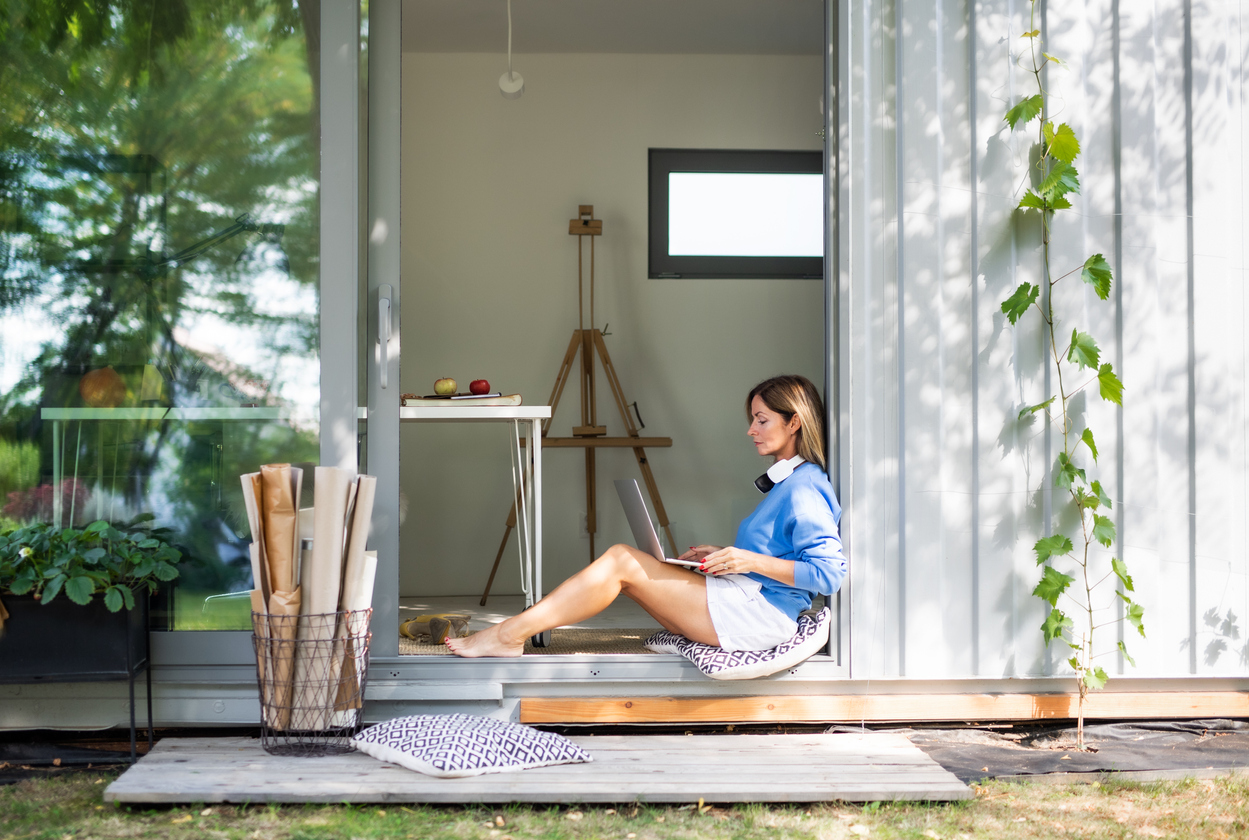There’s never been a better time to work from home. The world has adapted to accommodate remote workplaces, which benefits employees who choose to take advantage. Creating a healthy work-life balance is easier if you work from a home office. Your hours are likely to be more flexible, and you’ll save a lot of time without the need for commuting. If all the rooms in your home are spoken for, consider turning your garden shed into the perfect backyard office. Have a functional space to get the job done and all the privacy you need to stay focused.
Planning is key
Before you turn your shed into your home office, figure out what you’ll need the space to accomplish. Plan your renovation within your budget, and keep in mind that you can always build upon it in the future.
A backyard office from scratch
If you’re building a new shed from scratch, consider the size of the office you need before all else. If your office requires a simple desk and a computer, then something small is probably going to suit your needs. If you want some extras, plan for those in advance. Maybe you want room for others to sit or even a couch along one wall. No office is complete without a coffee station. Do you need a filing cabinet, storage, or a whiteboard? What size of desk do you require?
Use some graphing paper to sketch out the dimensions of your backyard office before you build. Add the furniture so you can examine your potential floor plan and ensure you love your layout. Have ample room to move around without feeling crowded, and without wasting space you don’t need.
Since you’re building to suit your specific needs, consider hiring a contractor to create a custom-designed space.
Purchase a pre-built office
Opt for pre-built garden sheds, backyard offices, and cabins if building from scratch isn’t your cup of tea. Small wooden sheds offer plenty of space to store office essentials, such as desks and cabinets. Corner sheds are designed to fit snugly into the corner of a backyard or garden in an effort to maximize space.
You can get medium to large offices if you need to scale up your space or set up multiple desks and workstations. Large cabins often come as units with multiple rooms, so you can still have privacy while accommodating multiple people. Large cabins are the ideal way to go if you have a hybrid work model and want your space to serve several functions.
Remodel your current workshed
If you have an existing shed that can accommodate your needs, remodel it into your home office. To do this, empty it out and give its previous contents a home elsewhere, then thoroughly clean the shed’s inside and outside. Treat the outside of the shed to make it waterproof. Treating the wood has the added benefit of extending its average lifespan.
Check out the roof and ensure it’s in good condition, then move on to the walls – both inside and out. If there’s any rot, chipping or cracking paint, or other defects, repair them first. Your home office should stand up against the worst weather so you and your important electronics remain dry.
Renovate for comfort and function
It’s time to transform your old shed into a proper backyard office. Begin with a proper HVAC system that can heat your office when it’s cold and cool it when it’s warm. You’ll want to be comfortable when you work. Your HVAC system won’t have to work very hard if you properly insulate the office. Insulate the floors, the walls, and especially the roof. Ensure any windows and doors are weather-treated so your workspace stays at the appropriate temperature with ease.
You’ll also need electricity. Consider how many outlets you’ll require and where you want to put them. Hire an electrician to install the lights and outlets for you to ensure they’re safe. While you’re thinking about electricity, consider what you want for lighting. Lamps are cheap and easy to maneuver around the space, but you may prefer overhead or track lighting for a more classic office feel.
Backyard office furnishing

To truly optimize your comfort, think beyond the basics and embrace the concept of engaging office design, where furniture’s functionality is paramount. Here are some tips
Equipment and furniture
An office desk should accommodate your needs and be a useful storage space. Your desk should be large enough to hold all the equipment for your trade (if you require dual monitors, you’ll want a unit that can handle this). Folding desks and corner desks are great for small spaces, and a credenza is often a great choice if you have a lot of storage needs.
Office chairs are extremely important when it comes to comfort in an office. Your chair should be fully adjustable, from the height to the lumbar, armrests, and headrest. A great office chair has a seat depth that gives the back of your knees roughly two inches of space. Choose a chair with breathable material and wheels to help you move around without a second thought.
Ergonomics matter
The desk you choose should be appropriate for your height. Place your keyboard at elbow level so your body isn’t straining to reach it. Your monitor should be roughly 20 inches away from you and on a slight decline from your line of sight. If you’re sitting for long periods of time, consider a standing desk mechanism so you can occasionally stretch your legs without losing productivity.
Your chair is an investment when it comes to ergonomics. A great chair will lean, swivel, and roll as you require. It’ll have strong lumbar support and adjust to your ideal height. Investing in a proper desk and chair prevents strain on your body in the long run.
Lights transform the space
Bright computer lights can be a strain on the eyes, but with proper lighting, you can minimize that strain and even help separate your work and relaxation spaces. If you also plan to add a place to relax in your office, consider having two different hues of lighting. White lights will help your brain signify it’s time to work, while colored lights or warm hues signify that you’re in a relaxing or home environment.
Try creating bias lighting to avoid strain on your eyes, especially while using an LED monitor at night. These are LED lights for the backside of your monitor, which accomplish two things at once. First, it increases the amount of LED light levels without shining more light into your eyes or into the monitor itself, which would cause glare. Second, since you don’t see the source of the light, your eyes adjust to the ambiance of the lighting with far less strain. Televisions are made with this concept in mind, using lighting that adjusts the color based on what’s on the screen.
Home office decor
When considering extra home office décor, it’s best practice to avoid sharp, vibrant colors. These tend to catch the eye and offer a distraction. Go with pastels and neutral colors instead, which blend into the space rather than stand out.
Avoid overcrowding your office with too much furniture, as that may provide unnecessary chaos. Excellent home office décor will come in the form of open-access shelving, potted plants, and decorations that don’t steal your attention.
Protecting your backyard office
Now that you’ve successfully transformed your garden shed into a functional backyard office, it’s important to ensure the safety and security of your new workspace. Home security measures can provide peace of mind, protect your investment, and secure your work environment.
1. Secure your property
Install fences, locks, and security cameras to create a deterrent against theft and vandalism. A well-secured perimeter can discourage unauthorized access and protect your valuable equipment and documents.
2. Adequate Lighting
Illuminate the area around your backyard office with outdoor lighting. Consider using motion-activated lights to enhance security during the night. A well-lit space deters potential intruders and provides a safer environment for navigating during the evenings.
3. Insurance coverage
Review your home insurance policy to ensure your backyard home office is adequately covered. If it’s not included, consider purchasing additional coverage or a separate policy to safeguard your investment against potential damages or losses.
4. Document protection
Keep important documents such as permits, warranties, and receipts in a secure location within your backyard office. Consider investing in a fireproof safe to protect these documents from damage due to natural disasters or theft.
5. Organization and regular inspections
Maintain an organized workspace to reduce the risk of accidents and damage. Regularly inspect the structure for signs of wear or damage and address any issues promptly. An organized space is not only more efficient but also safer.
6. Fire safety
Install smoke detectors and fire extinguishers in your backyard office, and ensure they are well-maintained and up to date. Avoid storing flammable materials like gasoline or propane in or near the structure to minimize fire hazards.
7. Remote monitoring
Consider investing in a remote monitoring system that allows you to keep an eye on your backyard office even when you’re not physically present. Modern security systems often come with mobile apps, providing real-time alerts and peace of mind.
Productivity at work

Working from home has a lot of perks, but it also comes with a few potential problems. If you want to make the most of remote work, you’ll need to consistently do your best work without sacrificing your free time.
Time management
The best way to stay productive and achieve your goals is through proper time management. Having a solid morning routine puts you in your office, ready to go, at the same time each morning. If you have clear goals for the day and the entire week, you’ll work harder to achieve them.
Incorporate small, scheduled breaks throughout the day to keep fresh and lessen fatigue. Have clear times when you work and when you take breaks. It also helps to practice wellness by getting exercise throughout the workday.
One of the best ways to stay productive when you work from home is by utilizing productivity apps. These apps help you manage your time effectively, communicate with online teams, and keep you on task. Apps that help you track the time spent on specific products or challenge you to maintain work sprints can help you reach specific goals.
Work-life balance
A well-defined schedule dictating when you work and when you stop is a great tool for creating work-life balance. To double down on this concept, set your work notifications to only ping during your work hours.
Working from home can feel isolating, but there are ways to take advantage of the freedom it gives you. Break up your workday with personal errands, especially ones that involve interacting with people. Plan activities, like workout classes, reading a book, or the occasional coffee with friends after work, so you don’t feel shut off from your network.
When you get up on a workday, follow the same routine you would if leaving home for a day of work. Have a shower, eat some breakfast, and make your coffee. Keep your workspace dedicated to productive work, and only visit it when you intend to be productive.
Managing distractions
Using your workspace strictly for productivity is ideal, and there are ways to further manage your distractions. When you step through your office door, set your phone to “do not disturb” and don’t bring other distracting media into your space. Use your regularly scheduled breaks to catch up on anything you missed. You’re going to get distracted once in a while, and that’s okay. Sometimes, things need your attention, and there’s no avoiding it. Do your best, but don’t let this become a habit.
Working from home with children
When you work at home and have children, communication is your best friend and ally. Teach your children that you shouldn’t be disturbed when you’re at work. Let your kids know when you’ll take a break and how long the break will be. If your child’s needs interrupt your schedule, communicate with coworkers about how you’ll still complete your goals.
Converting your garden shed into a backyard office has several benefits. You get to create the space that’s right for you and set it up with functionality and comfort in mind. Working from home provides a lot of flexibility, saves you travel time, and can help create an excellent work-life balance. Some challenges come with working from home, such as optimizing your productivity with all those extra distractions. However, if you stick to a schedule and set yourself boundaries and goals, you can come out ahead.




